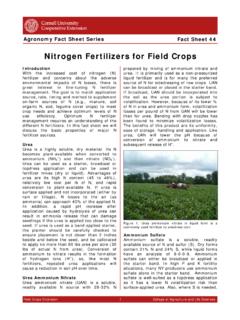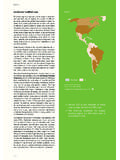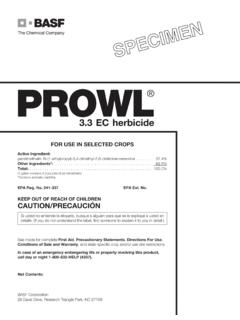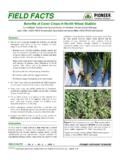Transcription of NtP Africa's Indigenous Crops LM final - …
1 STATE OF THE WORLD 2011 Innovations that Nourish the Planet africa S Indigenous Crops January 2011 africa s Indigenous Crops Table of Contents African Eggplant. The Fruit That s Enjoyed as a Bambara Bean. A Native Solution to africa s Food Crisis?..3 Baobab. Mother of the Cowpea. The Little Legume that Dika. West africa s Most Eligible Wild Egusi. The Miracle Enset. Tree Against Hunger ..8 Finger Millet. A Once and Future Fonio. africa s Oldest Cereal Needs More Lablab. The Bountiful, Beautiful Locust Bean. An Answer to africa s Greatest Needs in One Marama. The Green Gold of Marula.
2 Food, Function, and Sustainable Monkey Orange. Mouthwatering Moringa. The Giving Pigeonpea. A Little Crop That s Come a Long Potato. Potato, Safou. The Butterfruit ..19 Sorghum. Rise to Teff. A Grain with Many Reasons to Authors: Amanda Stone, Abby Massey, Molly Theobald, Matt Styslinger, Dan Kane, Dan Kandy, Alex Tung, Abisola Adekoya, Janeen Madan, and Elena Davert Editor: Lisa MastnyAfrica s Indigenous Crops 1 Introduction Finding ways to alleviate hunger and poverty doesn t always depend on new crop varieties that are bred in a laboratory.
3 Instead, reigniting an interest in and a taste for Indigenous and traditional foods can help improve nutrition, increase incomes, restore agricultural biodiversity, and preserve local cultures. Worldwatch Institute's Nourishing the Planet team traveled to 25 countries across africa talking to farmers, agricultural experts, and others about fruits, vegetables, and grains that can be found close to home and include a bounty of flavors. We' ve compiled this list of Indigenous African Crops some lesser known than others that deserve wider attention as the global agricultural community looks for effective ways to nourish both people and the planet. To learn more about the Nourishing the Planet project, visit africa s Indigenous Crops 2 African Eggplant The Fruit That s Enjoyed as a Vegetable While there are many varieties of the African eggplant, with a range of shapes, sizes, and colors, the eggplant most commonly found across sub- Saharan africa is Solanum aethiopicum.
4 This variety has a brilliant red exterior and is about the size and shape of an egg, giving it the name garden egg. It is also known as mock tomato, ngogwe, and nyanya chungu. Although technically a fruit, garden egg is usually picked when it is green and eaten as a vegetable, cooked into stews and sauces or even consumed raw. If it is picked after it ripens, it can be enjoyed as a fruit, although some varieties are sourer than others. Even the plant s leaves provide a nutrient- rich meal: in the markets of Kampala, Uganda, they are the most popular vegetable for sale. Most garden eggs sold in markets in sub- Saharan africa are grown locally on small plots of land, and as much as 80 percent of total production comes from small- scale growers.
5 Women, in particular, use the eggplants as an additional source of income. Garden eggs have proven to be resistant to molds, mildews, and certain soil- borne pathogens. The plant itself can grow in agricultural wastelands, is somewhat drought resistant, and has the ability to grow in humid areas. It can be grown alongside other Crops or in small pots, providing a high yield of fruit from a small area. Farmers will typically first harvest the fruit after 70 to 90 days, when it is still immature, and after that anywhere from 8 to 10 weekly harvests can be reaped. Once harvested, the eggplant can be stored for up to three months, and some consumers dry the fruit to eat later in the year.
6 Although the garden egg is not well known for its nutritional content it is 92 percent water it provides vitamin B, beta- carotene, and vitamin C, in addition to calcium, iron and potassium. Like many other Crops Indigenous to africa , the eggplant is easy to grow and high yielding, making it a good plant for research. Scientists at the World Vegetable Center have been working to improve the African eggplant since 1993 and released a new variety, DB3, in Tanzania in 2006. Since 2007, the Center has been working in countries within three different agroecological zones Cameroon, Madagascar, and Mali to test and release different varieties of eggplant.
7 Developing these new and different varieties of eggplant will help increase the availability and consumption of the fruit. These improved traits will be needed to resist the effects of climate change and meet the rising demand for Crops across the African continent. africa s Indigenous Crops 3 Bambara Bean A Native Solution to africa s Food Crisis? Ever heard of the Bambara bean? How about nyimo or Vigna subterranea or the African groundnut? No matter what you call it, this little bean, Indigenous to tropical africa , is highly overlooked by scientists, development agencies, and humanitarian programs, even though it packs a lot of nutrition.
8 The Bambara bean may have originated in Mali, but it is also popular in Burkina Faso, Cameroon, Nigeria, and Zimbabwe. It is now widely distributed and grown in Asia, parts of northern Australia, and South and Central America, and is often found for sale on street corners in Johannesburg, South africa . One reason the bean is growing in popularity is because it is a hardy plant, able to withstand high temperatures and dry conditions. It also has a variety of uses. The leguminous plant, in the same family as the peanut, produces seeds that taste somewhere between a chick pea and a haricot bean or garden pea. The seeds are typically boiled, canned, roasted, or fried, then ground and blended into many traditional African dishes.
9 When boiled, they are eaten as a snack, but they can also be added to stews and used to produce flour. In addition, the seeds can be extracted for oil. The Bambara bean is high in protein, particularly methionine, which makes the protein more complete than that in other beans. In addition, the bean has the highest concentration of soluble fibers, a trait that has been shown to reduce heart disease and certain types of cancer. According to a 2006 report from the National Academies of Science, the nutritional balance [of the Bambara Bean] is so good that some consumers claim they could live on the seeds alone. Its high protein level makes the Bambara bean not only a low cost and dependable cash crop for subsistence farmers, but also a valuable weapon in the battle against hunger across africa .
10 This little bean could go a long way in helping to fight africa s food crisis. africa s Indigenous Crops 4 Baobab Mother of the Sahel The basic needs for human survival include food, water, and shelter. Baobab, a tree Indigenous to the semi- arid regions of sub- Saharan africa , can provide all three and more. Baobabs are found in mainland areas of the continent from Senegal s coast to northern South africa , as well as on Madagascar, where seven out of the eight species occur. The baobab s leaves, fruit, and seeds are all edible. In West African countries, including Burkina Faso and Ghana, the leaves are commonly ground up and used in soups, as well as for condiments and sauces served with yam, cassava, maize, millet, and sorghum.










